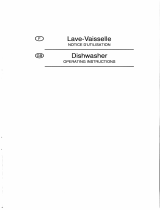1
Protection against water damage
• The
anti-overflow
safety device. The system automatically activates the drain pump if the water
level in the tub rises too high.
Protection contre les dégâts des eaux
• La
sécurité anti-débordement
. Ce système active automatiquement la pompe de vidange si le
niveau d’eau dans la cuve atteint une hauteur anormale.
Wasserschutz
•
Wasserschutz gegen Überlaufen
: Dieses System aktiviert automatisch die Ablauf-pumpe, falls
der Wasserstand im Innenraum zu hoch ist.
Vandskade sikringer
•
Overløbssikring.
Dette system aktiverer automatisk udtømningspumpen, såfremt vandniveauet i
maskinen bliver for højt.
Protecção contra deteriorações provocadas pela água
• A segurança
anti-transbordamento
. Este sistema activa automaticamente a bomba de
escoamento se o nível de água na cuba atinge uma altura anormal.
Bescherming tegen waterschade
•
Overloopbeveiliging
. Dit systeem zet de afvoerpomp automatisch in werking als het waterniveau
in de kuip een abnormale hoogte bereikt.
•
• La
seguridad antidesbordamiento.
Este sistema activa automáticamente la bomba de
vaciado cuando el nivel de agua dentro de la cuba alcanza una altura anormal.
zzaabbeezzppiieecczzeenniiee pprrzzeedd sszzkkooddaammii wwyywwoo³³aannyymmii pprrzzeezz wwooddêê
•
ZZaabbeezzppiieecczzeenniiee pprrzzeedd pprrzzeellaanniieemm
. System w³¹cza automatycznie pompê spustow¹ je¿eli
poziom wody w zbiorniku osi¹ga nienormaln¹ wysokoœæ.
F
GB
D
DK
P
GB
The photograph above, with the
lower basket removed, shows the
main points described in this
Instruction Book.
1
-
Upper basket
2
-
Cleaning liquid container
3
- Regenerating salt container
4
- Self-cleaning micro filter
5
- Rating plate (After sales
service references)
6
- Lower sprinkling arm
7
-
Main filter
8
- Waste trap
9
- Rinsing product container
Das Photo w.o. mit entferntem
Unterkorb veranschaulicht die
wichtigsten Teile, die in dieser
Gebrauchsanleitung beschrieben
werden.
1
- Oberkorb
2
- Spülmitteldosierer
3
- Salzvorratsbehälter
4
- Selbstreinigender Mikrofilter
5
- Leistungsschild (Referenz
Kundendienst)
6
- Unterer Sprüharm
7
- Hauptsieb
8
- Schmutzfalle für
rückstandfreie Sauberkeit
9
- Klarspülmitteldosierer
P
A foto acima, com o cesto inferior
retirado, permite-lhe visualizar os
principais elementos descritos
neste manual de utilização.
1
- Cesto superior
2
- Distribuidor de produto de
lavagem
3
- Reservatório de sal
regenerador
4
- Microfiltro automático
5
- Placa sinalética (Referência
S.A.V.)
6
- Braço de aspersão inferior
7
- Filtro principal
8
- Colector de detritos
9
- Distribuidor de produto para
enxaguar
D
La photo ci-dessous, panier inférieur
retiré, vous permet de visualiser les
principaux éléments décrits dans cette
notice d’utilisation.
1
- Panier supérieur
2
- Distributeur de produit de lavage
3
- Réglage de l’adoucisseur
4
- Réservoir à sel régénérant
5
- Plaque signalétique (Référence
S.A.V.)
6
- Bras d’aspersion inférieur
7
- Filtre principal
8
- Piège à déchets
9
- Distributeur de produit de rinçage
F
DK
Fotografiet her under viser de
vigtigste elementer i
opvaskemaskinen, der kan ses, når
det nederste stativ er taget ud. Det er
disse elementer, som er beskrevet i
betjeningsvejledningen.
1- Øverste stativ
2- Rum til opvaskemiddel
3- Instilling af blødgøringsmiddel.
4- Rum til regenererende salt.
5- Maskinplade (Service referencer)
6- Nederste sprøjteelement
7- Hovedfilter
8- Affaldsrist
9- Rum til skyllemiddel
1
2
3
4
5
6
8
9
7
PL
NL
GR
GR
PL
Zdjêcie poni¿ej, z koszykiem
wyjêtym, umo¿liwia zapoznanie siê
z g³ównymi elementami opisanymi
w instrukcji.
11
- Koszyk górny
22
- Dozownik œrodka myj¹cego.
33
- Regulacja zmiêkczania
44
- Zbiornik soli
55
- tabliczka znamionowa (Znak
serwisu po sprzeda¿y)
66
- Ramiê spryskuj¹ce dolne
77
- Filtr g³ówny
88
- Wnêka na odpady
99
- Dozownik œrodka do p³ukania
NL
Bovenstaande foto vertoont de
belangrijkste onderdelen van het
apparaat met uitzondering van de
onderste servieskorf. Deze
weergave zal U helpen bij het lezen
van de handleiding.
1
- Bovenste servieskorf
2
- Afwasmiddelbakje
3
- Instelling van
wateronthardingsinstallatie
4
- Zoutreservoir
5
- Typeplaatje (referentie t.b.v. service)
6
- Sproeiarmen
7
- Hoofdfilter
8
- Afvalbakje
9
- Glansspoelmiddel reservoir
E
La presente fotografía, retirada la
cesta, le permite visualizar los
principales elementos que se
recogen en la presente guía de
utilización.
1
- Cesta superior
2
- Distribuidor de detergente
3
- Depósito de sal de
regeneración
4
- Microfiltro autolimpiable
5
- Placa se señalización
(Referencia SPV)
6
- Brazo de aspersión inferior
7
- Filtro principal
8
- Trampas de residuos
9
- Distribuidor de abrillantador
E

















